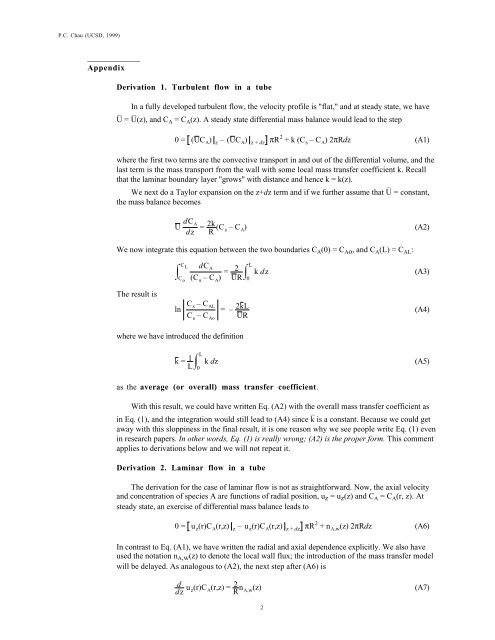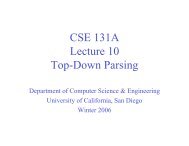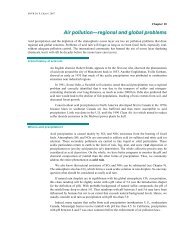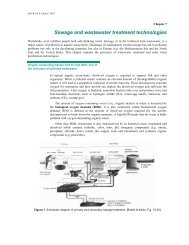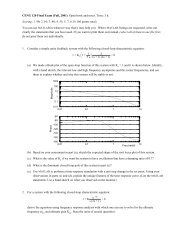Miscellaneous notes on mass transfer coefficient models
Miscellaneous notes on mass transfer coefficient models
Miscellaneous notes on mass transfer coefficient models
You also want an ePaper? Increase the reach of your titles
YUMPU automatically turns print PDFs into web optimized ePapers that Google loves.
P.C. Chau (UCSD, 1999)<br />
_____________<br />
Appendix<br />
Derivati<strong>on</strong> 1. Turbulent flow in a tube<br />
In a fully developed turbulent flow, the velocity profile is "flat," and at steady state, we have<br />
U – = U – (z), and C A = C A (z). A steady state differential <strong>mass</strong> balance would lead to the step<br />
0= (UC A ) z –(UC A ) z+dz πR 2 +k(C s –C A )2πRdz (A1)<br />
where the first two terms are the c<strong>on</strong>vective transport in and out of the differential volume, and the<br />
last term is the <strong>mass</strong> transport from the wall with some local <strong>mass</strong> <strong>transfer</strong> <strong>coefficient</strong> k. Recall<br />
that the laminar boundary layer "grows" with distance and hence k = k(z).<br />
We next do a Taylor expansi<strong>on</strong> <strong>on</strong> the z+dz term and if we further assume that U – = c<strong>on</strong>stant,<br />
the <strong>mass</strong> balance becomes<br />
U dC A<br />
dz = 2k<br />
R (C s –C A )<br />
(A2)<br />
We now integrate this equati<strong>on</strong> between the two boundaries C A (0) = C Ao , and C A (L) = C AL :<br />
C L dC A<br />
= 2<br />
(C s –C A ) UR<br />
C o<br />
0<br />
L<br />
k dz<br />
(A3)<br />
The result is<br />
ln C s –C AL<br />
C s –C Ao<br />
=– 2kL<br />
UR<br />
(A4)<br />
where we have introduced the definiti<strong>on</strong><br />
k = 1 L<br />
0<br />
L<br />
k dz<br />
(A5)<br />
as the average (or overall) <strong>mass</strong> <strong>transfer</strong> <strong>coefficient</strong>.<br />
With this result, we could have written Eq. (A2) with the overall <strong>mass</strong> <strong>transfer</strong> <strong>coefficient</strong> as<br />
in Eq. (1), and the integrati<strong>on</strong> would still lead to (A4) since k – is a c<strong>on</strong>stant. Because we could get<br />
away with this sloppiness in the final result, it is <strong>on</strong>e reas<strong>on</strong> why we see people write Eq. (1) even<br />
in research papers. In other words, Eq. (1) is really wr<strong>on</strong>g; (A2) is the proper form. This comment<br />
applies to derivati<strong>on</strong>s below and we will not repeat it.<br />
Derivati<strong>on</strong> 2. Laminar flow in a tube<br />
The derivati<strong>on</strong> for the case of laminar flow is not as straightforward. Now, the axial velocity<br />
and c<strong>on</strong>centrati<strong>on</strong> of species A are functi<strong>on</strong>s of radial positi<strong>on</strong>, u z = u z (z) and C A = C A (r, z). At<br />
steady state, an exercise of differential <strong>mass</strong> balance leads to<br />
0= u z (r)C A (r,z) z –u z (r)C A (r,z) z+dz πR 2 +n A,w (z) 2πRdz (A6)<br />
In c<strong>on</strong>trast to Eq. (A1), we have written the radial and axial dependence explicitly. We also have<br />
used the notati<strong>on</strong> n A,w (z) to denote the local wall flux; the introducti<strong>on</strong> of the <strong>mass</strong> <strong>transfer</strong> model<br />
will be delayed. As analogous to (A2), the next step after (A6) is<br />
d<br />
dz u z(r)C A (r,z) = 2 R n A,w(z)<br />
(A7)<br />
2


